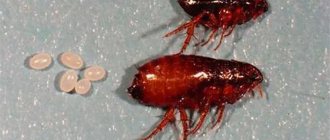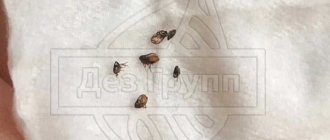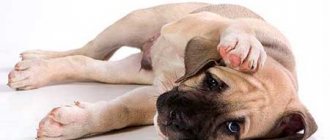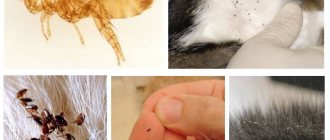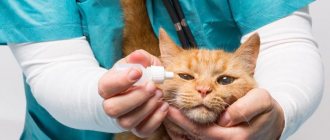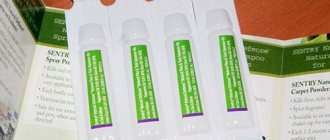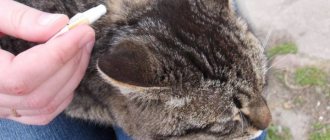Fleas are blood-sucking insects that feed on the blood of warm-blooded mammals. Common species: cat fleas (Ctenocephalides felis), human fleas (Pulex irritans), dog fleas (Ctenocephalides canis), rat fleas (Xenopsylla cheopis). These groups of parasites do not specialize in one host - the dog flea bites cats, the cat flea bites dogs, and the rat flea attacks people. Fleas are insects that undergo metamorphosis (complete transformation), including four stages of development - egg (7-14 days), larva (10-15 days), pupa (6-10 days), imago (3-18 months). Adult fleas jumping around the house and biting a dog or cat make up only 5-7% of the parasite population in the apartment, 35% are larvae, 10% are pupae, 50% are eggs. In addition, a flea does not live permanently on a pet’s body, so treatment against insects must be comprehensive: the use of drugs based on growth regulators to treat the animal + sanitary treatment of the premises.
There are many means to get rid of and prevent the appearance of parasites, the most effective of which are flea drops. They are used for the treatment and protection of sexually mature animals, kittens and puppies up to 3 months.
Methods of flea infestation
Most often, an animal becomes infected on the street, but even a domestic cat that has never left the apartment and has not been in contact with sick animals can become a victim of blood-sucking insects.
The main factor is the presence of eggs laid by fleas, which the owner himself can bring into the house, for example, on the sole of a shoe.
Close-up view of a flea.
Precautions and emergencies
If you follow all the requirements specified in the instructions, there will be no side effects in animals when using anti-flea drops. Only in rare cases is it observed:
- hair loss;
- increased salivation;
- allergic reactions.
If a dog or cat (especially small, pregnant, lactating, old) has a behavior change after treatment, do not use the medicine anymore and contact your veterinarian. Danger signs that indicate a serious allergy are:
- sleep disturbance;
- shiver;
- itching;
- dermatitis at the site of application of drops;
- lacrimation.
If the cat/dog licked the drops
For each drug, the instructions indicate that pets should not be allowed to lick it. But sometimes this happens due to the owner’s negligence, if the cat is very flexible and for other reasons. Depending on how much of the substance enters the body and how strong the animal’s immune system is, poisoning of varying degrees of severity is possible. Its signs:
- loss of appetite;
- strong thirst and profuse salivation;
- lethargy, loss of orientation, weakness;
- gastrointestinal disorders.
If an animal is poisoned by flea drops, consult a veterinarian.
To help your pet, do the following:
- The very first and most important step is to contact a specialist.
- Wash off any remaining insecticide from the skin.
- Make your cat or dog drink more water.
- Prepare rice water (1.5 cups per 0.5 liter of water, cook for 40 minutes) and give the sick pet a drink.
- Give Smecta (half a packet per 20 ml of water for an average cat and dog) or activated charcoal (dosage approximately the same as for humans: 1 tablet per 1 kg of weight).
- If you need painkillers, give 0.5 tablets of No-shpa.
To restore the intestinal microflora, Vetalact and other drugs that should be prescribed by a veterinarian are suitable.
If the product gets into your eyes
Contact of the insecticide with the eyes is undesirable. If this happens, rinse them as soon as possible with plenty of water. Consult a specialist if you notice any abnormalities that do not go away for a long time - redness, burning, blurred vision and others.
If a toxic substance gets into the eyes or inside the body of a pregnant dog/cat, kitten or puppy, then the consequences are more serious and the manifestations of poisoning are stronger. Be careful!
Pros and cons of using drops
In veterinary medicine, such a flea remedy as drops is common. Their advantages:
- ease of use;
- versatility - the drops additionally protect the cat from ticks, lice, lice and helminths;
- effectiveness - repeated prophylaxis should be carried out after 2-3 months (for each drug, the duration of action is indicated in the instructions).
Disadvantages of drops:
- most products are contraindicated in kittens under 12 weeks of age and pregnant cats;
- toxicity - at least 2-3 days must pass from the last bath of the animal until treatment with drops, so that a protective fat layer has time to form.
Applying drops to the cat's fur.
Overdose
Poisoning of dogs and cats with flea drops is extremely rare (3-5% of cases); the risk group includes sick, elderly, weakened animals, puppies and kittens.
Symptoms:
- drooling, increased sweating;
- vomiting (more often in dogs), nausea, diarrhea;
- uncontrolled eye movements, constriction of the pupils;
- trembling, shortness of breath, lethargy;
- frequent urination, fecal incontinence.
At the first manifestation of alarming symptoms, it is necessary to show the animal to a veterinarian. If it is not possible to do this immediately, you should give your pet a sorbent (activated carbon) to drink. Dosage: 1 tablet per 10 kilograms of weight. Plain water will help alleviate the severity of intoxication; it should be poured into the mouth every 15 minutes, 5-10 milliliters. There is no point in gastric lavage or enema - the drops are absorbed through the skin. If the condition worsens or dangerous symptoms increase (convulsions, shortness of breath), a visit to the clinic is essential to avoid the death of the animal. In a hospital setting, the doctor administers intramuscular or intravenous steroids to eliminate allergic manifestations, and prescribes IVs to promptly remove toxins, which improves the condition of the animal.
Flea drops are the drugs of choice for protection against blood-sucking parasites. They are effective, safe and affordable. The main thing is to adhere to simple rules: strictly adhere to the dosage, frequency and application technology. To enhance the effectiveness of the drops, it is recommended to use an anti-flea collar as an additional means.
At what age are flea drops used?
Almost all drugs are intended for cats aged 2-3 months, but there are also safe drops that can be used for treatment earlier.
Some cat drops suitable for pregnant and lactating cats are contraindicated for kittens. Therefore, to avoid harming the animal, read the package insert.
Frequency of treatment of kittens
To prevent the appearance of fleas, prevention is required once a quarter. If a kitten is infested with fleas, it should be treated with antiparasitic medication immediately.
Effective drops work instantly, killing blood-sucking insects from the first minutes of contact with the pet’s body.
Rules for handling pets
Before using drops, you must read the instructions for their use. The instructions contain information about indications, contraindications and precautions.
It is important to apply the drops not to the fur, but to dry skin without damage. Application area: near the back of the head (withers).
Standard rules for handling domestic cats:
- When applying the medicine, do not allow it to come into contact with the skin.
- After treating the animal, even if the drug was in ampoules, wash your hands thoroughly.
- In order to achieve maximum effect and be able to quickly identify adverse reactions, the kitten should be supervised for the first 2-3 hours.
- If your pet must be left alone, put a veterinary cone on him.
Methods of applying the drug.
Precautionary measures
The peak of toxicity, when the drops act, occurs on the first day. Therefore, it is forbidden to pet the animal and allow it near children.
If a treated cat accidentally comes into contact with human skin, rinse the area with plenty of water. Avoid contact with mucous membranes and affected areas of the skin.
Rules of application
Before applying the medicine, you must carefully examine the cat/dog's skin for rashes and wounds:
- drops are applied to the withers at one point, for greater effectiveness - along the ridge at several points, avoiding contact with the fur if possible. A small amount of the drug is applied under the neck, at the base of the skull, distributed over the back;
- The cat or dog should not be bathed 24 hours before and after treatment, so as not to damage the fatty layer of the skin. Compliance with this rule is mandatory; if ignored, treatment will have to be repeated;
- droplet protection weakens over time: the highest protection profile is observed in the first 7 days, after three weeks the containment indicator decreases by 10 points, after 4 - by 25-30 points.
How long before you can wash after applying drops?
The period before washing a cat after flea treatment depends on the composition of the product used. It takes 1-2 days for a water-based product to absorb, and about 5 days for an oil-based product.
If you notice allergy symptoms (itching, redness, fresh scratching), your cat should be bathed immediately. A local reaction to the use of the drug can cause irreversible consequences that will require urgent treatment of the animal.
In order not to harm the cat and to be sure that the necessary protective layer has been formed, it is recommended to use the drops 2-3 days after bathing. In some cases, this period is 5 days.
Drops on the withers from AVZ
"Four with a tail" with a repellent effect.
This product is not an insecticide, but a repellent. It does not kill insects, but repels them. It contains lavender, citronella and schizandra oils, which give the product an aroma and at the same time prevent lice, lice-eaters, fleas and ticks from approaching. The product protects against fleas for up to 8 weeks, and against ticks for up to 3 weeks. Thanks to natural ingredients, it is also safe for kittens.
BARS® FORTE against fleas and ticks for cats.
The drug simultaneously gives both a repellent and insectoacaricidal effect. It prevents insects and ticks from approaching the cat, scaring them off with its smell, and at the same time kills existing parasites. It destroys both the fleas themselves and their eggs with larvae, is effective and safe.
BARS® FORTE against fleas and ticks for kittens.
A variation of the product intended for kittens will help get rid of fleas or ticks even in young ones. It still cannot be used on very young (under 10 weeks) kittens, or on pregnant or lactating cats, but this medicine will help pets weighing less than 1 kg.
BARS® against fleas and ticks for cats.
A well-proven and proven insectoacaricidal agent. Contains fipronil, diflubenzuron and dicarboximide. The use of the dicarboximide synergist makes BARS® especially effective for walking cats.
Attention! Cat drops can be toxic to rabbits, ornamental insects and fish.
What happens to fleas after treatment?
Drops have a detrimental effect on parasites in one of three ways:
- Impact on the nervous system, resulting in death.
- Contact action. A toxic substance with a poisonous effect penetrates the insect’s body through direct contact.
- Repellent effect. The smell of some products can only repel fleas, but will not lead to their destruction.
Protection from parasites.
Advantages over other insecticidal drugs
suppress the onset of fleas , ticks , and intestinal parasites in a variety of ways. But if you want to get rid of unwanted guests as soon as possible and for a long time, insecticidal drops will be the best remedy .
The popularity of such tools can be explained simply:
- All types of drops are produced in special dropper pipettes . Thus, calculating the dosage of the drug is significantly simplified;
- You can treat a cat captivated by fleas even without outside help;
- most drop manufacturers exclude the possibility of re-infection with parasites within several months after using the product.
What to do if drops don’t help
Flea medications may not be effective in the following situations:
- The medicine was chosen incorrectly.
- Application rules not followed.
- The dosage was calculated incorrectly.
- The date of preventative treatment has been missed.
- The drug is used after the expiration date.
If you have treated your cat according to the instructions, but there is no effect, contact a veterinary clinic for help.
Veterinarian help.
How to choose effective drops
Choosing an anti-flea agent is a serious matter, since not all drops are equally safe and effective. Before purchasing them, you should consult with your veterinarian so that he can help you calculate the dosage depending on the weight/age of your pet.
Instructions:
- Study the range of drops in a veterinary pharmacy, paying attention to the concentration and degree of toxicity of insecticides and additional substances. The effectiveness of the drug is determined on the basis of special tests, the result of which is the “flea control” index; it should be at least 80-90%; if the figure is lower, it is better not to buy drops.
- Make sure that the expiration date has not expired.
- Consider the age of the cat or dog: drops for puppies and kittens, weakened animals, lactating/pregnant bitches have a lower content of active ingredients.
- You should not treat cats with drops for dogs and vice versa - this can lead to intoxication of the animal.
- It is not recommended to use two or more types of drops at the same time - this is fraught with a weak antagonist, suppression of transport and synergy, and an abnormal increase in toxicity. Conditionally safe options: phenylpyrazoles + pyrethroids; if necessary, carbamates can be added to the mixture.
Bars ─ inexpensive drops of domestic production
Antiparasitic products produced by AgroVetZashchita are especially popular among Russian consumers.
Drops on the withers Bars and Bars Forte are much cheaper than the vast majority of foreign analogues.
At the same time, according to reviews from dog breeders, they are quite effective. The poisonous action is based on such a powerful insecticide as fipronil. Bars Forte drops also contain an insect growth regulator, which allows you to destroy not only adults, but also larvae and eggs.
The drug is sold in pipettes, each of which contains 1.4 ml of the substance. For dogs whose weight does not exceed 10 kg, 1 pipette is enough. An animal weighing from 10 to 20 kg is treated with 2 doses, and over 20 kg - 3 - 4 doses. The manufacturer states that with correct use of the drug, insects are expelled from the animal’s body within 24 hours, and preventive protection lasts 3 months against fleas and 1 month against ixodid ticks.
There are also a number of contraindications due to which this drug is not suitable in some cases. Thus, Bars drops cannot be used on dog breeds whose normal weight does not exceed 2 kg. In addition, it is not recommended to use the drug on puppies under 3 months of age. These drops are extremely contraindicated for pregnant dogs and animals suffering from any chronic diseases or having serious injuries.
Rules for antiparasitic treatment
The method of using the drops is described in detail in the instructions supplied with them. To achieve the expected result and minimize the likelihood of side effects, be sure to familiarize yourself with it before starting to treat your pet.
Where to drip?
Flea drops should be applied at the base of the animal's neck, between the shoulder blades. If the animal is large, a few drops can be distributed further along the spine, but only in those places where the animal cannot reach and lick the drug. During the procedure, you need to make sure that the liquid gets on the skin. In order for the product to be absorbed into the epidermis faster, the drops can be rubbed in yourself, but this must be done with gloves.
How many drops should you apply?
The amount of the drug is calculated based on the attached instructions. The dosage depends on the size and weight of the pet. Most often, the drops are packaged in special pipettes of different capacities or ampoules, each of which is intended for one-time treatment.
In what cases does it not help?
Sometimes it happens that after treatment with flea drops, they do not have the desired effect. Possible reasons why the drops did not help and the parasites did not die:
- the product was chosen incorrectly;
- the rules for using the drug were violated during processing;
- incorrect dosage;
- using a product that has expired;
- skipping preventative treatment.
Itches
If the treatment was carried out strictly according to the instructions and the drops did not help, it is recommended to consult a doctor.
How long does it take for them to start working?
When fleas disappear after using drops depends on the type of drug. Most of these products begin to work after 10-12 hours and continue to work for a month. Re-treatment is recommended after 4 weeks.
On a note! Modern flea drops remain active even after interaction with water. However, it is not advisable for your pet to take water treatments for a long time after treatment or to be exposed to the rain.
